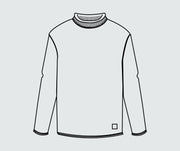
Product Care
Here at Finisterre, all our products are built with meticulous attention to detail. Everything is made to stand the test of time. But caring for your kit in the right way is a big part of making sure it lasts for as long as possible. To keep your gear fit for purpose and performing through the years, you’re in the right place.
What Do You Need Help With?
General Care
Proper care of a garment can significantly extend its lifespan and provide lasting longevity joy. We provide you with a guide to help you care for your clothes.
Video Tutorials
How to wash...
Wetsuit
Knitwear
Waterproof
Insulation
Wash less
Before washing your clothes, have a smell, do they just need an airing outside or hung in a steamy bathroom? Think before washing – don’t use the washing machine as a tidying tool. Washing garments too often can damage the fibres and hence decrease the lifespan. Dry cleaning uses harmful chemicals that flatten the natural fibres in some fabrics and also decreases the lifespan.
Wash at low temperatures
When the time comes to using the machine, wash at lower temperatures with a natural laundry detergent to prevent colour fading. Item in close contact with skin, like bedding and towels, may need a higher temperature wash.
Pay attention to care labels
Due to the way fabric is made it requires different approaches to laundering. It’s a good idea to have a look at the instructions on the care label, which advise you on the maximum temperature and spin. For example wool should have no spin.
Cut down on dry cleaning
Although we often avoid buying dry clean only clothes, most delicate items labelled as ‘dry clean only’ can be washed on a low temperature with low spin. Dry cleaning is a highly chemical intensive process that has negative impacts on the environment, the textile fibres and our skin. Where dry cleaning is the only option for the garment, look for environmentally friendly cleaners offering non-toxic and ‘eco’ cleaning services.
Use eco-laundry powders and detergents
Standard detergents can contain fossil fuel-based substances, which do not biodegrade. There are now a growing number of eco-laundry products that are made from biodegradable, plant-derived ingredients, which are also refillable.
Wash inside out
Washing clothes inside help keeps the clothes in better condition for longer as the abrasion happens to the fabric on the inside and keeps the outside fresher. Also over filling the machine can cause increased fiction on the clothing and damage the fibres.
Air dry or tumble
Freshly laundered air-dried clothes smell and feel amazing. Air drying is better for your clothes and the planet compared to tumble drying.
Shake out the creases in your clothes and hang outside on the washing line, drying rack or on hangers to dry. Pay attention to clothing labels as clothing such as wool jumpers are better dried flat.
Tumble drying is a useful tool when drying Insulation. The Finisterre insulation and waterproofing benefits from a tumble to increase the durability of the waterproofing qualities and DWR surface. So this is recommended at a low heat.
Store properly
Store all clothes in a cool and dry space to protect them from damp, sunlight, and heat, which can all cause damage. Make sure clothes are clean before storage, as dirt can attract moths. Try storing your knitwear with lavender for added protection against moths. It’s important to not overfill your wardrobe, as clothes need breathing space.
When hanging clothes, use wooden or padded hangers to further protect garments from becoming misshapen.
Repair damage
Repair any damage to a garment when you first notice it. See our in-house repair service to repair your garments. This will keep the item out of landfill and will increase the lifespan of the item and decrease carbon emissions. A repaired garment takes on a new life, the emotional attachment and trust for the garment deepens and it becomes the go to companion.
Alter to fit or refresh the style
A simple alteration like taking a garment in at the waist or shortening a pair of trousers or a dress can give you what feels like a fresh new outfit, and also keep your old favourites updated. At Finisterre we can take up a hem, have a look at our online service.
Stain Removal
Wax
Use brown paper with no shiny side to it. Place the brown paper on top of the wax and press the iron over the top, heating the wax and soaking it up into the brown paper. Keep moving the paper until all the wax is soaked up.
Red Wine
Rub with water and put salt (for cashmere or silk: dry shampoo) on the stain. Then carefully brush out and wash. For dark shadows after treatment: apply shaving foam, leave to act and wash out.
Coffee
Rub out with mineral or warm tap water. If the stain has already dried: Put salt or baking soda on the stain and brush it out carefully.
Oil/Fat
First soak up oil/fat with paper towels - then wash out with hot water and washing-up liquid. Use bile soap (in one piece) for stains that have become stale. For delicate fabrics - such as silk - alcohol can be used.
Make-up
For non-sensitive, light or dark clothing: bile soap or baking soda. Otherwise stain spray or stain remover, apply to the stain before machine washing.
Sweat
Soak overnight in warm water bath with a dash of vinegar. Rinse with cold water the next day. Then wash in the washing machine as usual.
Water Marks
For non-sensitive, light or dark clothing: Mix bile soap with plenty of warm water and rub out the water marks generously with it.

Jacket Care
Whether keeping you warm in dawn chills or dry in coastal storms, our jackets are built to protect you from the elements, but a little care goes a long way. These guides will help keep your jacket performing through the seasons.
Waterproof Jackets
- Machine Wash At 30
- Gentle Cycle
- Do Not Bleach
- Do Not Use Fabric Softener
- Do Not Dry Clean
- Do Not Wring Dry
- Line Dry Or Low Heat Tumble Dry
- Re-Proof When Necessary
Insulated Jackets
Machine wash at 30C
Gentle cycle
Do not bleach
Tumble dry low until completely dry to restore water repellency and regain loft
Do not use fabric softener
Do not dry clean
Do not wring dry
Do not iron
Re-proof when necessary
If my coat needs re-proofing, how do I do this and what can I use?
We recommend using a Storm Washcare product, should your coat need a reproof or just some general TLC. Great products, all FC free. Dependent on your jacket and the fabric, you may need to wash the item according to the instruction provided by Storm Washcare.
You can find the Storm Washcare range here.
Alternatively, we do offer a reproofing/wash service, for £25 at our Finisterre HQ.

Knitwear & Fleece Care
Wool is an incredible natural fibre. It’s antibacterial and requires far less washing than most people think, but never say never: if your knitwear needs a wash, always follow the label. These care guides will also help.
Knitwear & Wool Fleece
1. Handwash
It is recommended to hand wash the wool rather than machine washing it. Fill a basin or sink with lukewarm water and add a mild detergent. Gently submerge the garment in the water, avoiding twisting or wringing the fabric. Rinse thoroughly with cool water until all the soap is removed.
2. Dry flat
After washing, lay the garment flat on a clean towel, roll the towel up and press gently to remove excess water. Then, lay it flat on a drying rack or a fresh towel, in its original shape, to air dry.
3. Avoid direct sunlight and heat
Do not expose the garment to direct sunlight or heat, as this can cause the fabric to shrink or stretch. Instead, dry it in a shaded area or indoors.
4.Store properly
Make sure it is clean and dry. Fold the garment carefully and store it in a drawer or on a shelf, away from direct sunlight and moisture.
5. Use a lint roller
To remove any loose fibres or pills that may have formed on the surface of the garment, use a lint roller or a fabric shaver.
Recycled Polyester Fleece
Machine wash cold on a gentle cycle
Wash with similar colours
Do not bleach
Tumble dry low, remove promptly
Do not iron

Wetsuit & Swimwear Care
Wetsuits
Yulex Wetsuits
Rinse Your Suit Inside And Out With Fresh Water After Use
Hang Your Suit In Half And Line Dry Avoiding Direct Sunlight
Do Not Machine Wash
Do Not Dry Clean
Do Not Tumble Dry
Do Not Iron
Swimwear
Swimsuits
Rinse After Use
Wash Inside Out
Machine Wash Cold On Gentle Cycle
Do Not Use Fabric Conditioner
Do Not Bleach
Do Not Wring
Do Not Tumble Dry
Line Dry Avoiding Direct Sunlight
Do Not Iron
Do Not Dry Clean

Cotton & Denim Care
From hardwearing trousers to soft t-shirts and jumpers, our gear is designed to stand the test of time. These care guides will help your kit stay durable, capable, and ready for your next adventure.
Cotton
Machine Wash At 30
Wash With Similar Colours
Low Spin
Dry Flat Away From Direct Heat Or Sunlight
Dark Colours May Transfer When Damp
Do Not Tumble Dry
Cool Iron
Do Not Bleach
Denim
Machine Wash At 30
Wash Inside Out
Gentle Cycle
Wash With Similar Colours
Dark Colours May Transfer When Damp
Do Not Bleach
Do Not Tumble Dry
Cool Iron

Repairs
Breathe new life into your best-loved gear with our repair-at-home kits and patches, or we can even fix your favourite pieces for you. Because the most sustainable product is the one you already own.
I've damaged my favourite Finisterre jacket/jumper/item. What can I do?
Never fear! We have our very own in house repairs here at Finisterre who are dedicated to breathing life and happiness back into your beloved Finisterre favourites. You can now book a repair online here - then simply follow the instructions and send the item to us, for our repairs team to get started on.
How long will my Repair take?
Our team are super-efficient, but to get the best results can take time. We will do our best to get your items repaired within 4-6 weeks. This can change dependant of the time of year, so please bear this in mind.
Can I get any non-Finisterre items repaired?
Unfortunately, for now we are only able to repair Finisterre Items, so our apologies for any disappointment.
What do I need to do before I send in my gear?
Wash the garment, taking care to follow wash-care instructions on product care label, send back using instructions shared with you via email.
































































































